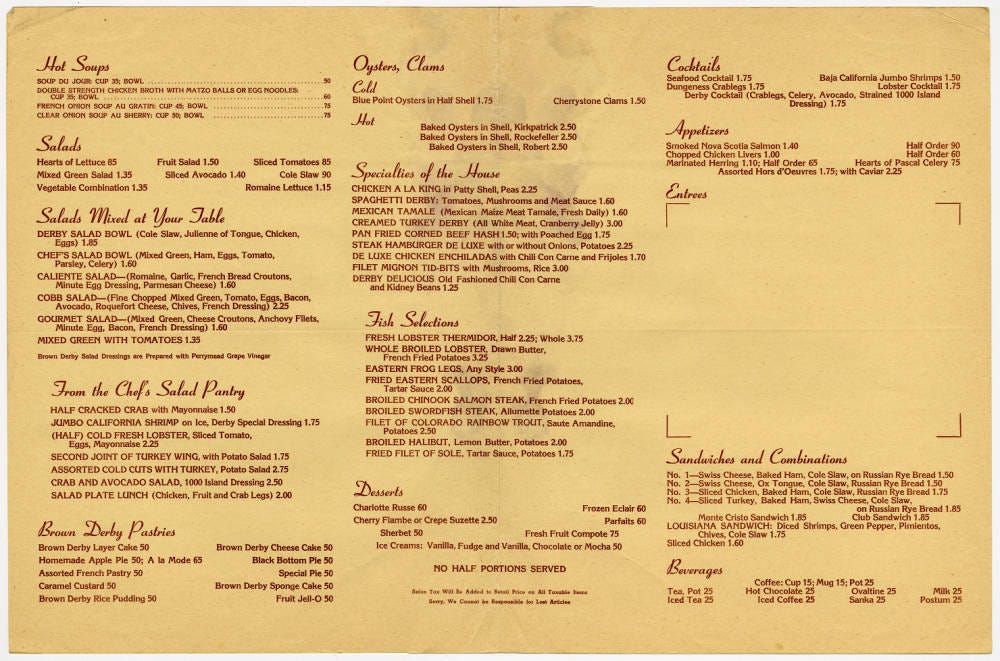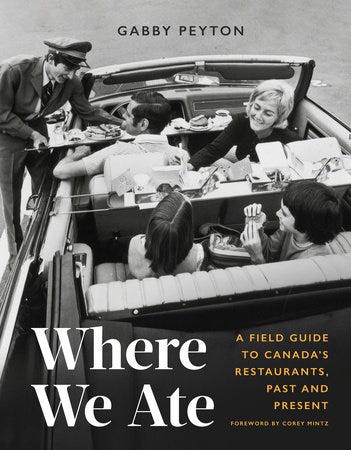Entry-level Cobb (Salad)
A history of the celebrated salad and a very good Balsamic Vinaigrette
A scene from one of my favourite movies epitomizes the revered nature (and flexibility) of a Cobb Salad. In the 2009 film Julie & Julia, down-on-her-luck office worker Julie Powell, played by Amy Adams, has to meet her successful college friends for the “dreaded ritual Cobb Salad lunch,” which she fears will only highlight her failure to launch as a writer. (Don’t worry she makes it big later by blogging about cooking the whole Julia Child cookbook — if you haven’t seen the movie, you should!)
Cut to her arriving late for lunch in a bustling New York City restaurant filled with business folks.
And the order?
“I’ll have a Cobb Salad no blue cheese,” says one well-suited friend.
“I’ll have a Cobb Salad no beets,” whispers the next while on the cellphone.
“I’ll have a Cobb Salad no bacon,” adds the next.
“I’ll have a Cobb Salad no eggs,” says Powell finally.
And the ladies who lunch begin the bragging.
This scene is representative of the pop culture and culinary history surrounding the dish — the improvisation of a Cobb Salad is foundational to its beginnings, and the beauty in this big-name bowl of greens all comes from a big brown bowler hat.
The history of Cobb Salad
If you’ve eaten at a restaurant called The Brown Derby, chances are it was named after the Los Angeles institution. It was first opened in 1926, but in 1936 the restaurant moved up a block, landing at 3377 Wilshire Boulevard and was reopened inside a giant brown bowler hat, a Brown Derby.
Many restaurants across North America beared the same name — there was even one here in Newfoundland, in Windsor, owned by P.J. Connors in the 1940s, inspired by an American restaurant he had visited. There were even subsequent restaurants in Los Angeles as the restaurant expanded. The second location of The Brown Derby in Hollywood opened in 1929 close to the movie sets ready to feed hungry actors, and this is where the Cobb Salad was created.
The Cobb salad is named for its creator, Robert (“Bob”) Cobb, who ran the renowned Hollywood restaurant. According to culinary lore, one night in 1937 Cobb concocted a salad for his friend Sid Grauman (of Grauman’s Chinese Theatre), improvising with what was in the fridge at the midnight hour — lettuce, cheese, tomatoes, chives, hard-boiled eggs, avocado, chicken, and bacon, which he chopped up and tossed with French dressing.
The next day, Grauman ordered another “Cobb Salad” and the legendary salad was born.
And again, improvisation is the mother of invention — the Buffalo chicken wings’ origins are similar as you can read in a previous newsletter.
The Brown Derby sold more than four million Cobb Salads out of its Hollywood location which closed in 1985. Two years later, Disney picked up the license to the Brown Derby franchise and these days you need a ticket to the theme park to snag a reservation at The Brown Derby restaurant inside Disney Hollywood Studios, which still serves a Cobb Salad.
Feeling Cobb-y?
Not only is the Cobb salad lovely to look at — a feast first for the eyes with its symmetrical lines of ingredients arranged in a gastronomic rainbow — it’s also a delicious lesson in texture.
There is beauty in its flexibility. Just like those ladies who lunch in Julie & Julia, swapping ingredients or subtracting them can make for a Cobb adventure.
The Cobb Salad in its traditional formation is delicious and fabulous - but I think of it like a base. A rainbow of ingredients changing with the seasons. A variety of vegetables can be used. The modern Cobb can be anything as long as the textures and flavours are balanced. You need the hit of creaminess from the cheese, but that hit of acid could easily come from a pickled red onion and for me, bacon and egg are necessities.
Interestingly, although these days the Cobb is served with blue cheese or ranch dressing, it was originally served with Cobb’s interpretation of French dressing made with red wine vinegar, olive oil, lemon juice, Worcestershire sauce, dry mustard and garlic. I’m more partial to the vinaigrette style in my Cobb.
The anatomy of a vinaigrette, and a very good Balsamic Vinaigrette Recipe
Vinaigrettes are all about ratios. The most important is the ratio of oil to vinegar which can vary depending on the cook. In Mark Bittman’s seminal cookbook How to Cook Everything he states the standard ratio is 3-1 as it is three parts oil to one part vinegar, while Julia Child’s basic vinaigrette calls for four parts oil and one part vinegar and in this Food52 article on salads, Sohla El-Waylly says it should be one-to-one vinegar and oil!
I’m more partial to a slightly creamier vinaigrette that coats even the lightest of greens. My golden ratio of a great vinaigrette is 3-2-1-1. 3 parts olive oil, 2 parts vinegar, 1 part dijon mustard, 1 part sweet (like maple syrup or honey).
Here’s my go-to recipe for a simple balsamic vinaigrette.
Ingredients:
½ cup olive oil
¼ good quality Balsamic Vinegar
1tbsp Dijon Mustard
1tbsp Maple syrup
½ tsp kosher salt
¼ fresh cracked pepper
½ tsp of Italian seasoning (optional: you can substitute for Herbes de Provence or dried chilli flakes if you’re feeling fiery.)
Directions:
Combine all ingredients into a jar, shake until emulsified and enjoy. Serve immediately, or can be stored in the fridge for up to a week.
Where We Ate is a great holiday gift!
My book is part coffee table book, part history book and part cookbook! It’s ideal for restaurant lovers, history buffs and anyone who wants a pretty green book on their coffee table. It’s also on SALE on Amazon and at Indigo. Grab your copy now!









Off to a resto for lunch and they have Cobb on the menu. I'll have to have that :-)